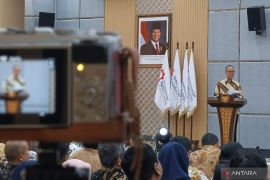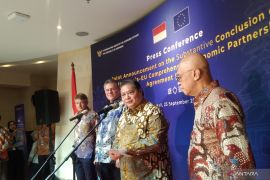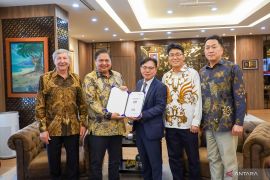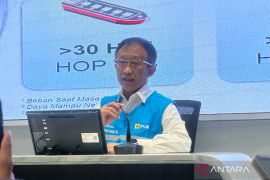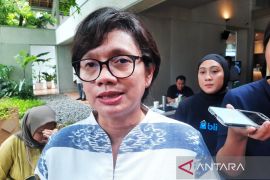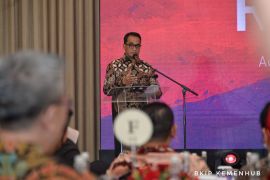In addition to being an eco-friendly transportation vehicle, battery electric vehicle (EV) is also deemed to be able to make Indonesia into a major player for the vehicle's main components.
President Joko Widodo noted that the key for 60 percent of the electric car components lies in the battery. Indonesia has a material reserve to create abundant stock of batteries.
As a form of the government's commitment, several derivative regulations have been issued.
These include Presidential Regulation No. 55 of 2019 on Battery Electric Vehicle for Road Transportation Program Acceleration.
The other is Presidential Instruction No. 7 of 2022 on the Use of Battery Electric Vehicle as Central and Regional Government Institutions' Operational State Vehicle and/or Individual Vehicle.
Moreover, at least six Transportation Minister's Regulations stipulate the implementation of EV in Indonesia.
In general, these regulations stipulate type test, conversion guideline, and technical guidance related to Non-Tax State Revenue (PNBP).
According to the Transportation Ministry's data, the demand for state operational vehicles, from Internal Combustion Engine to Battery Electric Vehicle, until 2030 reached 398,530 for two-wheeled vehicles and 132,983 for four-wheeled vehicles.
Meanwhile, Type Test Registration Certificates had been issued for 48,162 electric vehicles until January 2030.
Along with technological developments in future, one can only imagine how many electric vehicles will be plying on Indonesia's roads within the next few years.
Related news: Ministry promotes circular economy approach on used EV batteries
Related news: Indonesia has all key components to produce electric cars: Jokowi
Waste recycle
While numerous parties agreed that electric vehicle is far more eco-friendly as compared to oil-based car, the potential dangers of electric vehicles exists.
The waste from its main component, the battery, can cause serious environmental pollution if it is not managed well.
The National Research and Innovation Agency (BRIN) found that potential waste that should be considered is used battery, waste from the battery production process, and waste from the battery recycle process.
Electric vehicle generally uses lithium ion battery (LIB) that comprises cathode, anode, electrolyte, separator, and various other components.
Several materials used in LIB include heavy metals and electrolytes that can pose a threat for the ecosystem and human health.
If used LIB is simply thrown away in large quantity, then this can cause toxic heavy metal infiltration to groundwater that causes serious environmental pollution.
Similarly, if used LIB is burned as solid waste, then this will produce large quantity of toxic gas in the form of hydrogen fluoride (HF) that comes from electrolytes in LIB, which can pollute the atmosphere.
To this end, waste management of used battery is deemed necessary.
Head of BRIN's Transportation Technology Research Center Aam Muharam stated that several studies were conducted on the possibilities of reusing used battery through recycle.
Battery waste is usually graded or sorted first to know its capacity or age relative to its end-of-cycle.
If the battery's capacity is between 50-80 percent, used battery can be utilized once again as a second-life battery.
Second-life battery is a battery used for different purposes, such as for energy storage or stationary use.
If the battery's capacity reaches below 50 percent, then the battery can be recycled to extract valuable materials in order to produce new batteries.
Recycle can also be conducted by utilizing used battery as raw materials to create different products from the battery, such as ceramic pigments or metal alloy.
"Used battery produced from recycling requires durability test to see how much they can be used again. There should be regulations or standards that stipulate this," Muharam explained.
Studies related to battery waste recycling in BRIN are conducted by researchers in the Sustainable Material & Recycling Group.
The most frequently used methods in the recycling process are the pyrometallurgical and hydrometallurgical methods. These methods have their respective advantages and challenges.
For pyrometallurgy, the process is relatively simpler because it is similar to metal smelting in general.
However, this process requires large quantity of energy since it necessitates high temperature. Moreover, the purity of precious metals at the end of pyrometallurgical processes tend to be lacking and require further purification.
Meanwhile, the hydrometallurgical process has a series of complex and long processes. However, the recovered precious metal can be extracted with high efficiency.
One of the researchers within the Sustainable Material & Recycling Group, Sri Rahayu, noted that both processes require pre-treatment.
This includes discharging the battery, sorting the used battery based on the type, and destroying the used battery.
This step is conducted before entering the main recycling process to improve the efficiency of metal extraction and to minimize the amount of energy needed for the recycling process.
Circular economy
In line with this, the Environment and Forestry Ministry encourages all stakeholders to manage the waste from EV battery through a circular economy approach.
Claimed to be a new model from the reduce, reuse, and recycle concept, circular economy maximizes the usability and added value from a material, component, and product.
This can reduce the amount of leftovers that are not used and dumped into landfills.
The circular economy approach also involves raw material design planning, product design, and production process to produce longer usability cycle.
"The process begins from collection, destruction, and chemical processing with eco-friendly technology," ministry's official, Rosa Vivien Ratnawati, said.
Recycling EV battery as a sustainable raw material is considered to be more eco-friendly since it minimizes the use of new raw materials.
Moreover, it provides economic benefits, as it reduces the production cost for electric vehicle's main components.
The ministry urged vehicle manufacturers and repair shops to have a collection facility for used batteries to be delivered to EV battery waste users, Ratnawati remarked.
She also expects that the battery raw materials are not exported abroad, but processed by domestic battery manufactures as suppliers of vehicle battery all over the world.
Through this approach, from upstream to downstream, Indonesia can maximize the benefits from the EV component with minimal impact to the environment.
Related news: Indonesia must compete with Thailand in EV ecosystem: minister
Related news: Infrastructure no longer key issue in building EV ecosystem: ministry
Translator: Adimas R F P, Fadhli Ruhman
Editor: Sri Haryati
Copyright © ANTARA 2023


